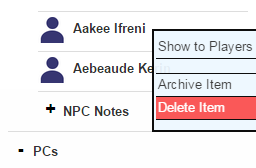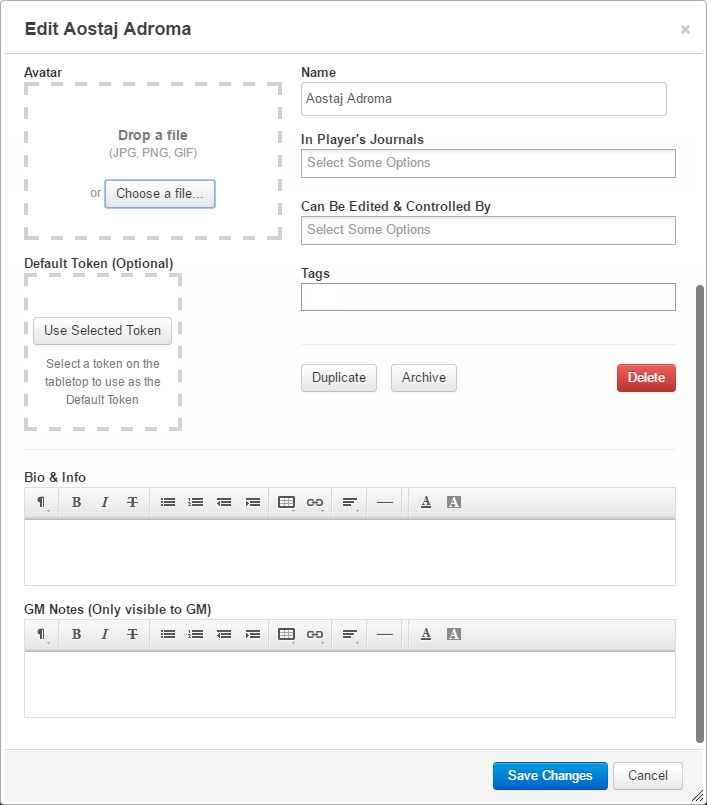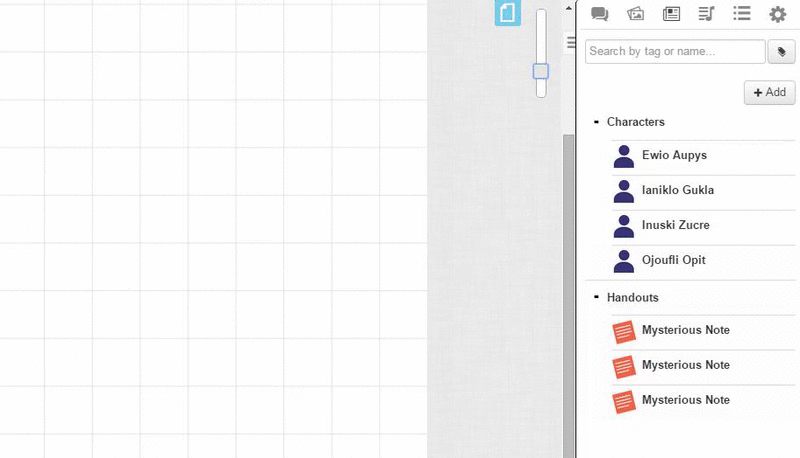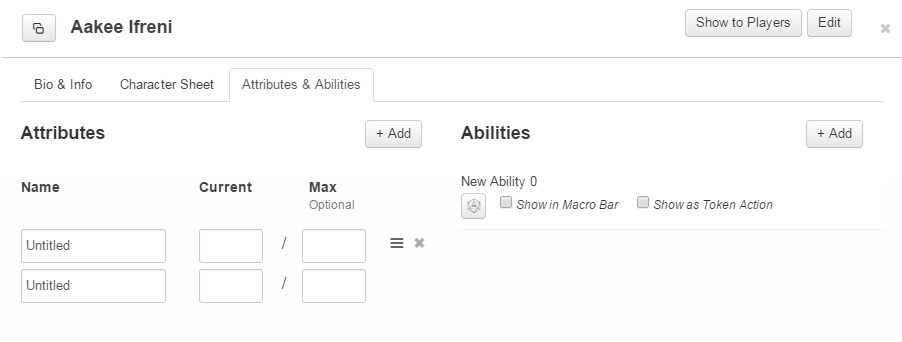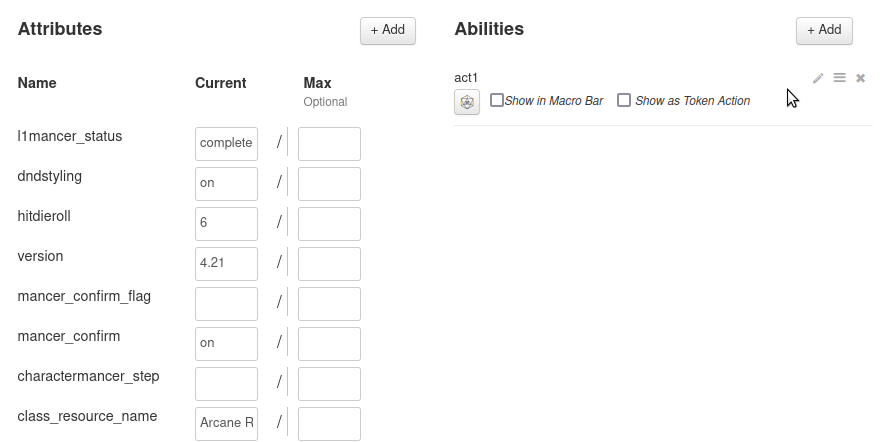Character
From Roll20 Wiki
Page Updated: 2022-11-21 |
Character
Main Page: Journal
Character are found and managed on the N Journal, and only a GM can create them. They work differently than Handouts. Character Sheet is a part within "Character" which is often used.
Character Journal entries are intended to represent either PCs, NPCs, or anything else that might take advantage of the various features Character Journals have, such as: Character Sheets, Linked Tokens, and Attributes and Abilities macros.
Contents[hide] |
Character Right-Click Options
While inside the Journal Tab, right-click the Character's Name to reveal the following options:
- Show to Players: This will force the Character Window to open on your players' Roll20 client for them to view. If your players don't already have permissions assigned yet to view this entry, Roll20 will ask you to confirm whether you want to show the entry to everyone.
- Archive Item: The Journal tab has an archival system, so you can store Character and Handout entries away when not needed for play. This can help with keeping your Journal tab organized. Archiving a Character will remove it from view in the Journal tab and place it in the Archive that is displayed at the bottom of the tab as soon as a single item is placed in it.
- Note: an archived Character still loads at game startup, it's only hidden from view. Archiving Characters does not reduce load on campaign. Proinfo users have the option of using the Transmogrifier to move unused characters to & from a storage campaign.
- Note: an archived Character still loads at game startup, it's only hidden from view. Archiving Characters does not reduce load on campaign.
- Delete Item: This will permanently remove the Character entry from the Journal Tab. This can't be undone, so Roll20 will ask for confirmation before initiating the deletion.
The Character Window
Click the Character entry's Name from the N Journal-tab to open it.
The Character Window Header
At the left hand corner is the ![]() Character Popout Button. Click this to pop this Character Window out into a new browser window. This can come in handy if you're a GM or Player who uses multiple monitors. Visit the My Settings page to set popout windows to automatic. Click the Show to Players button to reveal the Character to all players or click the "Edit" button to customize.
Character Popout Button. Click this to pop this Character Window out into a new browser window. This can come in handy if you're a GM or Player who uses multiple monitors. Visit the My Settings page to set popout windows to automatic. Click the Show to Players button to reveal the Character to all players or click the "Edit" button to customize.
To the right of the Journal Popout Button is the entry's Character Name. This is the display name for this journal entry and what you will see if you wish to refer to it elsewhere in the game like a macro, Chat As, or Token Representation.
On the right hand side of the Character Window are the following row of four buttons: ![]()
1. Show to Players Button: Clicking on this button behaves the same way as the earlier mentioned Journal Entry Right-Click Option Menu.
| Allow a Player to view, edit, and control a Character and Character Sheet, click the Edit button and add the Player or Players names to in Player's Journal and Can be Edited and Controlled by fields, finally click Save. |
3. Zoom Options Button: Clicking on this button gives you ability to increase or decrease the zoom of all content within the Character Window. At default, the zoom is set at 100%. This affects the view of all tabs within this window.
4. Close Window Button: Clicking on the X icon at the top right corner of the window will close it if you are in View Mode. If you are in Edit Mode, Clicking on the X button will revert you back to View Mode.
Edit
Only the GM can access the sheet Edit Mode
- In Player's Journals: By default, only the GM sees Characters in to the N Journal-tab. To allow other Players to see the Character in their N Journal, add their names to the "In Player's Journals"-field. Player names are only available once they've launched the game at least once. You can also choose "All Players" to allow everyone to view the Character.
Players who can view the Character will see the Name, Avatar, and any text typed in the Character's Bio & Info field only. They will not have access to the Character Sheet-tab (if applicable) nor the Attributes and Abilities-tab.
- Can Be Edited & Controlled By: Adding players to "The Controlled By" field gives them the following permissions:
- They will be able to choose the Character from the "Speak As" drop down menu in the q Text Chat-tab.
- They will be able to edit the Character's Name, Bio-text field of the Bio & Info- tab.
- If the game uses a Character Sheet, they will have permission to view AND edit information on Character Sheet-tab.
- They will be able to control any Token set to Represent this Character. See Linking Token to Character Sheet-guide for more details.
You can also choose "All Players" to allow everyone to control or edit the Character entry.
- They will be able to choose the Character from the "Speak As" drop down menu in the q Text Chat-tab.
- Tags: The Tags field allows you add Tags to the Character entry so that you can quickly find it later using the Search box at the top of the Journal tab on the Sidebar.
- Duplicate: Using the "Duplicate"-feature will create a duplicate of the current Character entry on the N Journal-tab with the name "Copy of (original-character)". This can be useful when using a Character entry as a template for new Character entries.
- Archive: This button behaves exactly as the Right Click Option in the Journal Tab. Archiving the Character will put it in long-term storage. Once you've archived at least one Character or Handout entry, an Archive icon will appear at the bottom of the Journal Tab.
- Delete: Deleting the Character will permanently remove it from the Game. This cannot be undone!
Avatar
The Avatar, (aka. Character Portrait), is an image that represent this Character in the Journal listing (it replaces the default thumbnail) as well as the Chat interface. Drag and drop an image from your computer, use the Choose a file...-button to select the image from a file explorer, or drag and drop an image from the Art Library into the box. Once an image is added, you can remove it at any time by hovering your mouse over the Avatar area and clicking on the Remove link that appears in the upper right of the square.
Default Token
The Default Token field gives you the ability to select a token on the tabletop to use as the default token for this Character whenever it is added to the table. Just select a token on the Tabletop, then press the "Use Selected Token" button. A copy of the token will be stored, including any notes, player permissions settings, and bar values and links. A GM or a player that can Edit and Control this Character can then drag-and-drop the Character from the Journal listing in the right sidebar onto the tabletop, and a new copy of the Character's default token will be added to the table.
Once a Token is tied to a Character in the Journal, a Shift+Click on the Settings icon when a token is selected or Shift+Double Clicking on the token directly will open the attached Character; Alt+Click opens the character to the Attributes & Abilities tab. You can also drag and drop the character name from the N Journal-tab to add tokens directly to the tabletop, once a token has been linked to it's Character. To drag-n-drop a character/token from the N Journal, you need to select its name, not the character icon/three bar. If you select the icon (or three horizontal bars) to the left of the name, it will move the character's position in the Journal.
| Useful Tip: For PCs, set up all your tokens ahead of time and assign them to their respective PC Character entries. Then when your Players join your game, just give them control of the Character and they'll be able to control all the tokens for that Character right away. Please see the Linking Token to Character Sheet-guide for further details. |
Character Tabs
The Character Window will either have two or three tabs of content depending on whether your game is using a Character Sheet. They are listed in this order:
- Bio & Info Tab: This tab is where you edit the basics of the Character entry from Name, to its assigned Token, User Permissions, as well as a place to take PC and GM notes.
- Character Sheet (optional): If your game is using a community or Roll20 created Character Sheet, it will show up on this tab.
- Attributes & Abilities: This tab is where you can create custom attributes and macros to roll dice formulas from. (Note: If you're using a Character Sheet, there will already be Ability fields created to be used by the Sheet.)
The following sections will go over each tab in detail.
Bio & Info Tab
- Name: This will change the Character Name for this Entry.
- Bio & Info Field: The Bio & Info field allows you to input information about the Character.
- GM Notes Field: Use the GM Notes area to add additional notes that only the GM can see.
| Note: Both Bio and GM Note fields have text formatting options available, as well as, the ability to add tables and copy and paste from PDFs or other Word Documents. |
Character Sheet Tab
Main Page: Character Sheet
Your Character may also have a Character Sheet-tab, which is a way to display information about the character which mimics a paper character sheet for the game you are playing. Your GM will set this feature up if it's available for your game. Filling out the sheet is usually fairly straightforward, just click on any text/number-field, and enter your information. Some fields will also auto-update based on other information (for example, your Strength Modifier may auto-calculate based on the Strength of your Character). Finally, Character Sheets often have roll buttons which you can click to quickly perform skill checks and other actions (such as attacks) for your Character.
The complexity and sophistication between different character sheet templates can vary a lot, from being a simple digital version of the game's paper sheet where you just use it for storing simple info and numbers, going all the way to to having integrated character creation tools, i Compendium-compatibility, detailed settings, and options to customize the sheet and dice rolls made from it.
Roll20 have a massive number of option from sheets to use for game systems. Sheets that have by Roll20 in their name (~15 sheets) are created and maintained by Roll20, but the majority of sheets (several hundreds) are created & maintained by the community. A number of sheets are maintained by publishers themselves.
Related:
Attributes & Abilities Tab
The Attributes & Abilities Tab is used to track the Attributes of the Character if you don't use any Character Sheet template, or want a custom stat, and store rolls and other chat commands that could be used by that Character.
Attributes
| Note: If you have a Character Sheet-tab, you seldom( or never) need to edit any Attributes on the A&A-tab, as it can interfere with how the visual sheet functions. Most of the sheet's stats, apart from repeating sections, are mirrored there. |
You can add Attributes to your Character by clicking on the + Add Button in the Attributes column. Each Attribute requires a Name, as well as, a Current Value and an (optional) Max Value. Any players that you give permission to edit/control the Character entry will also be able to edit and add more Attributes. Attributes can be used as variables in Macros and Abilities.
Macro Creation
- Complete Guide to Macros & Rolls
- q Text Chat
- Dice Reference
- Order of Operations
- Macros
- Token Reference
- Character Reference
- Roll Templates
- Roll Table
Advanced
- Formatting
- HTML Replacement
- Chat Menus
- Hidden Rolls
- Advanced Macro Tips
- API Commands
- Char Sheet Creation
- External tools
Misc.
To call an Attribute within on the Character Sheet Tab or within an Ability-macro on the Attributes & Abilities Tab), it follow this format: @{AC}, @{level})
If you want to call a specific character's attributes in the q Text Chat or in a Macro, you need to specify the name of the character (e.g. @{Charlie|level}), or use:
- Selected Token with a Macro
@{selected|level} - Targeted Token with a Macro
@{target|level}
Abilities
| This section could do with a cleanup (March 2021) |
Abilities are designed to work in conjunction with Attributes, and work almost exactly as Macros.
You can input any valid chat command (rolls, emotes, etc.) into an Ability, and by using an Attribute that the character have as a variable, you can create complex Character-based Abilities.
When creating an Ability, type @ to view a list of Attributes that can be used. Since the variable used in the Ability is linked to a Character Attribute, the value will sync when changed in the Character editor.
You can easily add and remove Abilities from your Macro Quick-Bar by selecting the Character from the N Journal Tab.
Shift+Click on an Ability on the Macro Bar will open that Character's Ability editor. Abilities can also be used as Token Actions which is a token specific macro feature.
Abilities can be called directly from the chat by typing them similarly to an Attribute. The format is %{<character name>|<ability name}, for example: %{Bob the Slayer|Massive-Axe}
Finally, you can hover over Attributes and Abilities to drag and drop to re-order them or delete them.
Ability calls (e.g. %{Bob the Slayer|Massive-Axe}) always require a keyword (e.g. the Character Name keyword; "Bob the Slayer"), even within a tab of a Character Window. (e.g. %{Massive-Axe} won't work for Bob but %{selected|Massive-Axe} can.)
Ability Command Buttons can be used to call Abilities from the q Text Chat.
API
| This section is about a Roll20 feature exclusive to Pro-subscribers (and often to players in a Game created by a Pro-subscriber). If you'd like to use this feature, consider upgrading your account. |
Main Page: Character_Sheet#API
There are a number of APIs that helps with character & Character Sheet management, including options for players to create their own characters. See Character Sheet#API for more
Related Pages
- Pseudo-attributes
- N Journal
- Handouts
- External Journal - Plusinfo feature
- Character Sheet
- Character Vault
- Transmogrifier - Proinfo feature





